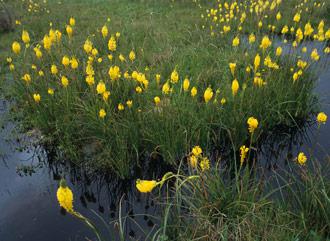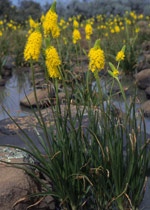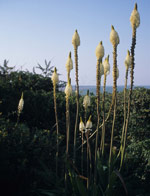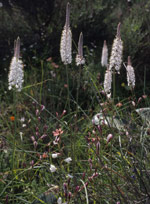Bulbinella
Bulbinella Kunth
Family: Asphodelaceae
Common names: bulbinella (Eng.); katstert (Afr.)
Introduction
The genus Bulbinella includes 18 species occurring in the Northern, Western and Eastern Cape Provinces of South Africa and an additional six species from the main islands of New Zealand. All the species have attractive orange, yellow, cream or white flowers in dense, unbranched racemes.

Description
Description
Tufted, deciduous perennials, solitary or forming clumps. Rootstock a compact rhizome surrounded by membranous cataphylls (small scale leaves) and often persistent fibrous leaf bases; roots somewhat fleshy.

Leaves few to several, spirally arranged, somewhat fleshy, round or triangular in cross section or strap-shaped and keeled, the margins smooth or minutely toothed. Inflorescence a more or less dense raceme; bracts small and papery.
Flowers star- or cup-shaped, the tepals free or united at the base only, white, cream, yellow, or orange, usually unscented but sometimes with a musty smell. Stamens inserted below the ovary and joined to the base of the tepals. Ovary ovoid with two ovules per locule; style slender.
Fruit a globose or ovoid capsule. Seeds one or two per locule, depressed-ovate and shield-shaped with a peripheral wing, black. Basic chromosome number x = 7.
Flowering time: Mainly flowering in late winter, spring and summer (June to January) in most South African species, although four species flower during the drier period between December and June. The New Zealand species usually flower between November and January.
List of species:
South Africa:
- B. barkerae P.L. Perry
- B. calcicola J.C. Manning & Goldblatt
- B. cauda-felis (L.f.) T. Durand & Schinz
- B. chartacea P.L. Perry
- B. ciliolata Kunth
- B. divaginata P.L. Perry
- B. eburniflora P.L. Perry
- B. elata P.L. Perry
- B. elegans Schltr. ex P.L. Perry
- B. gracilis Kunth
- B. graminifolia P.L. Perry
- 12a. B. latifolia Kunth subsp. denticulata P.L. Perry; 12b. B. latifolia Kunth subsp. doleritica (P.L.Perry) P.L. Perry;12c. B. latifolia Kunth subsp. latifolia; 12d. B. latifolia Kunth subsp. toximontana P.L. Perry
- B. nana P.L. Perry
- 14a. B. nutans (Thunb.) T. Durand & Schinz subsp. nutans; 14b. B. nutans (Thunb.) T. Durand & Schinz subsp. turfosicola (P.L. Perry) P.L. Perry
- B. potbergensis P.L. Perry
- B. punctulata Zahlbr.
- B. trinervis (Baker) P.L. Perry
- B. triquetra (L.f.) Kunth
New Zealand:
19. B. angustifolia (Ckn. & Laing) L.B. Moore
20. B. gibbii Cockayne 21. B. hookeri (Hook.) Cheeseman
22. B. modesta L.B. Moore
23. B. rossii (Hook.f.) Cheeseman
24. B. talbotii L.B. Moore
Conservation Status
Status
Red list assessments of the South African species from Raimondo et al . (2009):
- Least Concern (LC): B. barkerae, B. cauda-felis, B. chartacea, B. ciliolata, B. divaginata, B. elata, B. elegans, B. gracilis, B. graminifolia, B. latifolia subsp. denticulata , B. latifolia subsp. latifolia, B. nutans subsp. nutans, B. nutans subsp. turfosicola, B. punctulata, B. trinervis, B. triquetra
- Critically endangered (CR): B. calcicola CR A3c B. potbergensis CR B1ab(iii)+2ab(iii)
- Vulnerable (VU): B. eburniflora VU D2 B. latifolia subsp. doleritica VU B1ab(v)+2ab(v) B. latifolia subsp. toximontana VU D1+2 B. nana VU D2
Distribution and habitat
Distribution description
Bulbinella has an interesting and unusual, highly disjunct distribution. Although most of the species are restricted to winter-rainfall South Africa, six occur naturally in New Zealand. Most species favour moist, cool habitats.
Derivation of name and historical aspects
History
The name Bulbinella was first proposed by Kunth. The genus was named for its close similarity to Bulbine, from which it differs mainly in the glabrous filaments which are always hairy in Bulbine. Before Kunth's study the species formed part of the then polymorphic genus Anthericum L.
Ecology
Ecology
In South Africa the species are confined to the winter-rainfall areas. The species are found in a variety of habitats with different soil types, notably Table Mountain Sandstone and clay. The species do, however, prefer damp depressions, moist, shaded south-facing slopes, seasonal streams and seepage areas. Some of the species have very particular preferences and have limited distributions on a specific soil type. Pollination is facilitated by insects, notably honeybees, and the plants do not produce any nectar. Beetles have been noticed on some of the species, e.g. B. eburniflora , and may also play a role in pollination.
Uses
Use
There is no recorded ethnobotanical use for Bulbinella.
Bulbinella flowers are colourful and long-lasting in the vase. All the species are recommended as cut flowers.
Growing Bulbinella
Grow
The New Zealand species of the genus have enjoyed most of the horticultural attention, with B. hookeri and B. rossii being most frequently cultivated (Bryan & Griffiths 1995). Perry (1990, 1999) provides notes on the cultivation of the South African species.
They are best grown in pots, as the species are somewhat frost- intolerant. Plants may be grown from seed and in years to come, larger clumps may be divided towards the end of the dormant period. Care should be taken not to damage the roots when plants are divided or when digging around the plants.
Bulbinellas should not be lifted for storage because of the sensitivity of their storage roots to damage and desiccation. For the latter reason, it is also important to water plants lightly during the dormant season.
Species

Bulbinella latifolia subsp. latifolia occurs mainly in the Northern Cape where it forms large seasonal stands in seasonally wet areas. It is distinguished from B. nutans, to which it is most similar, by its taller stature, broader, spreading leaves and longer, narrower inflorescences. B. latifolia subsp. latifolia occurs in a variety of habitats, often along streams or dams on granite, peat and clay.

Bulbinella nutans subsp. nutans is found from the Cape Peninsula northwards as far as Loeriesfontein and eastward to Swellendam. It is most similar to B. latifolia from which it can be distinguished by its slightly smaller stature, narrower, erect leaves and shorter inflorescences. It is mostly found on clayey soils that are seasonally wet.

Bulbinella elata occurs from the West Coast north through Clanwilliam to Calvinia. Two colour varieties are found, a cream- and a yellow-flowered form. It typically has flat, spreading, leathery leaves and narrow inflorescences with small round capsules. This species occurs on clayey or granitic soils.

Bulbinella calcicola is a recently described species (Manning & Goldblatt 2010) restricted to the limestone outcrops around Jacobsbaai close to Saldanha. It is most similar to B. triquetra but differs in its broader, channelled leaves with narrowly cylindrical racemes and flowers that are orange-tipped.

Bulbinella cauda-felis is a variable species and is widespread throughout the Western and Northern Cape. It typically has narrow racemes of pinkish-white flowers and is often found on shady hillsides or flats on clay, sandy soils or coastal sands.
References
- Bryan, J. & Griffiths, M. (eds) 1995. The new Royal Horticultural Society dictionary: manual of bulbs . Timber Press, Portland.
- Manning, J.C., Goldblatt, P. & Snijman, D. 2002. The color encyclopedia of Cape bulbs . Timber Press, Portland.
- Manning, J.C. & Goldblatt, P. 2010. Bulbinella calcicola , a new species from Saldanha Bay, Western Cape. Bothalia 40: 197âe"199.
- Perry, P.L. 1990. Bulbinella âe" a neglected garden plant? Veld and Flora 79: 105âe"108.
- Perry, P.L. 1999. Bulbinella in South Africa. Strelitzia 8. South African National Biodiversity Institute, Pretoria.
- Raimondo, D., Von Staden, L., Foden, W., Victor, J.E., Helme, N.A., Turner, R.C., Kamundi, D.A. & Manyama, P.A. (eds) 2009. Red List of South African plants. Strelitzia 25. South African National Biodiversity Institute, Pretoria.
Credits
Stephen Boatwright and John Manning
Compton Herbarium, Kirstenbosch Research Centre
March 2012
Plant Attributes:
Plant Type: Bulb
SA Distribution:
Soil type:
Flowering season:
PH:
Flower colour:
Aspect:
Gardening skill:
Special Features:
Horticultural zones






Rate this article
Article well written and informative
Rate this plant
Is this an interesting plant?
Login to add your Comment
Back to topNot registered yet? Click here to register.